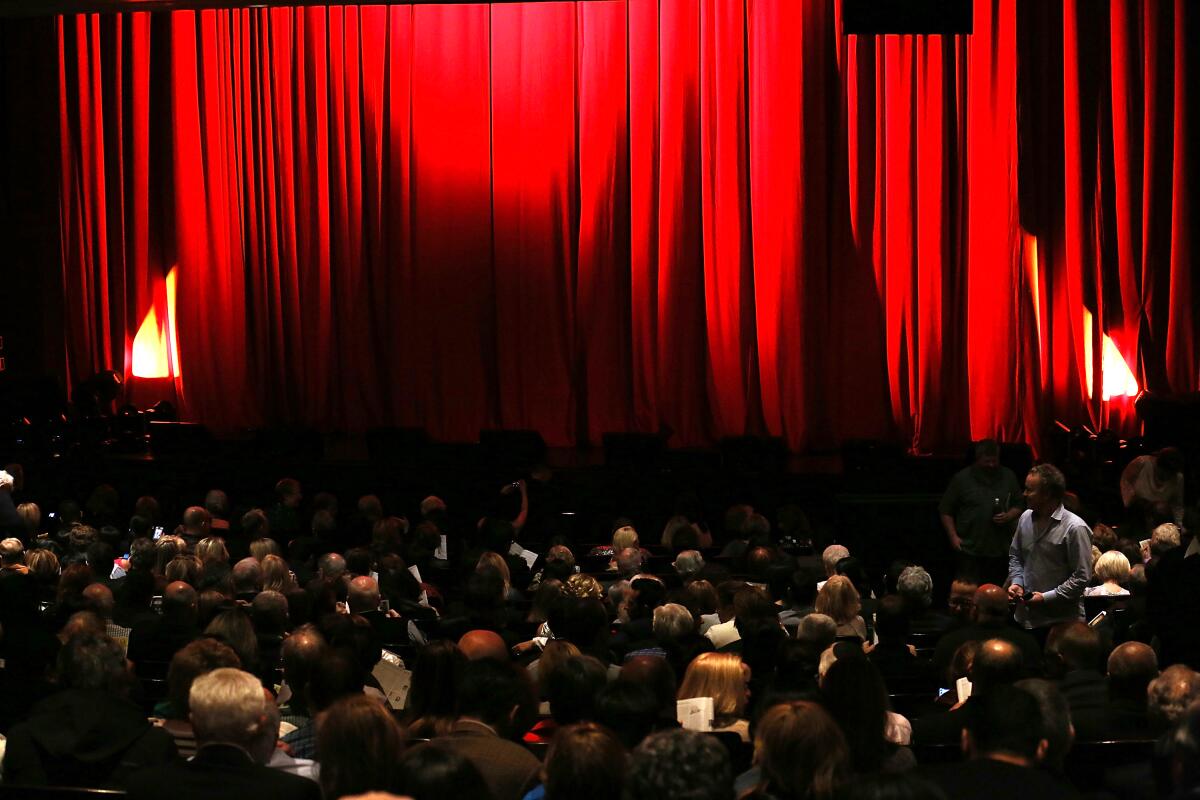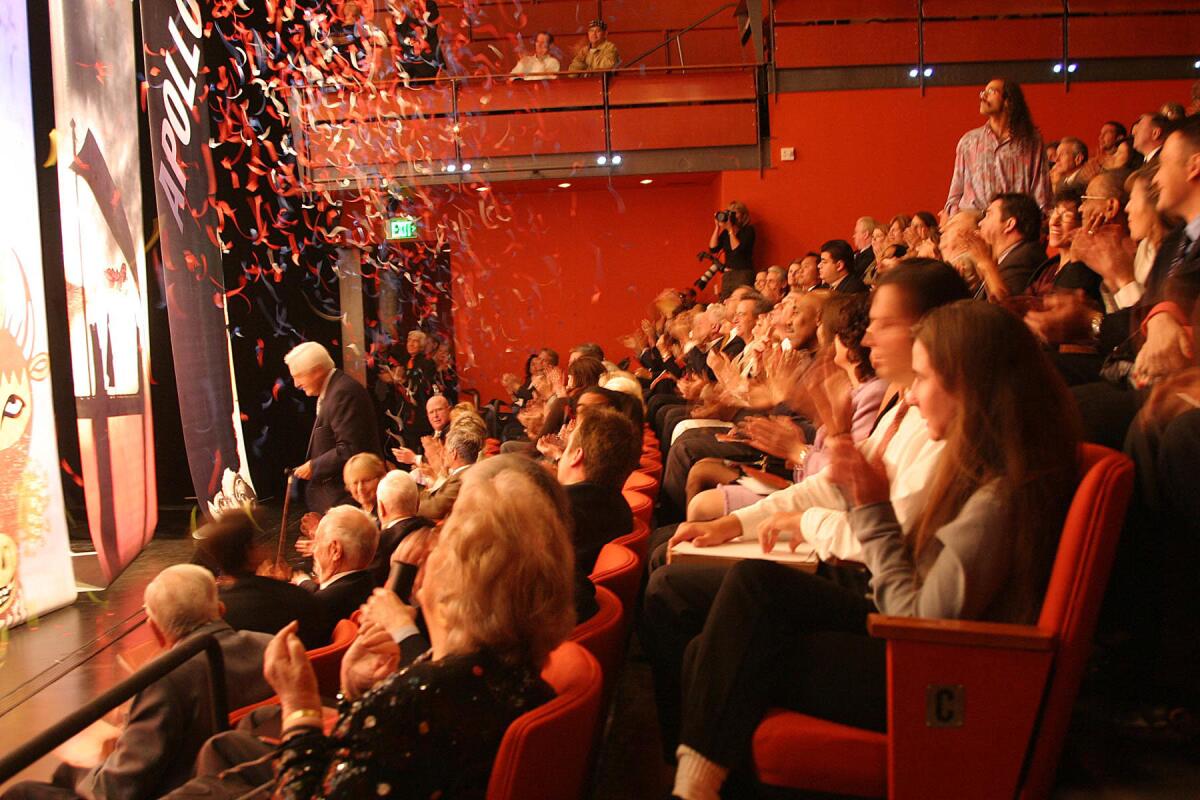The theatergoing habit is broken. How do venues get people back in seats?

- Share via
I’m Times theater critic Charles McNulty, filling in this week for Carolina A. Miranda. Usually theater news slows down a bit after the Tony Awards, but the shocking announcement that Center Theatre Group will be halting programming at the Mark Taper Forum has set off alarm bells throughout the arts world. It’s been a tumultuous week, so let’s catch up together.
What do theater audiences want anyway?
But first I wanted to address a topic to which I’ve been giving a lot of thought lately in my role as theater critic. It’s a question that artistic directors and producers have been pondering even more anxiously: What do today’s theater audiences want? Carefree fluff? More sensational distraction? Or something perhaps deeper and more difficult but not quite so evanescent?
Attendance declines have made this question more urgent. The COVID-19 pandemic didn’t just shut down venues for 18 months. It broke the theatergoing habit.
Regional theaters are having a particularly hard time putting back the pieces of their audiences. Subscriptions have long been a fundamental element of the nonprofit theater business plan. But surfeited with at-home entertainment options, former subscribers are preferring the flexibility of single-ticket sales. Why sign up for a season when you can pick and choose what you really want to see?
The obvious answer is to support a cultural organization in your community. But communal ties have frayed. One consequence of the decades-long commercialization of nonprofit theater is that patrons have been transformed back into consumers by companies that have been forced to rely to an ever-greater extent on box office revenue.

Buying a ticket to a show has become as transactional as a trip to the mall. The loyalty that Taper founder Gordon Davidson instilled in his audience has sadly become a relic of a bygone era.
Our digital culture and economy have only compounded the social disconnection. Netflix queues and social media feeds have made silos-for-one more luxurious than ever.
But the question of what theatergoers want is not the same as what will induce them to buy a ticket. The success of recent shows suggests that the right celebrity on the bill will still put butts in the seats, regardless of the quality of the vehicle. “Power of Sail,” no masterpiece, was the highest-selling season subscription production in Geffen Playhouse history. The not-so-secret weapon of this 2022 production was its star, Bryan Cranston, whose performance was everything you would hope it might be in a play I struggled to remember a few days later.
I wrote recently about Broadway audiences enhancing my experience of “Into the Woods,” “Parade,” “Sweeney Todd: The Demon Barber of Fleet Street” and “Fat Ham.” The spectator din at each of these shows was different in volume, tone and general excitability. In “Parade,” for instance, you could hear a pin drop as audience members followed the story of Leo Frank’s trial and antisemitic lynching. In “Sweeney Todd,” there was a boisterous electricity, which had partly to do with the magnificent singing (and gleeful fandom) of Josh Groban and partly to do with the genius of Stephen Sondheim.
Uniting these disparate offerings was the palpable concentration directed toward the proscenium. A group of strangers was converted by the ancient alchemy of theater into a collective thinking and feeling organism.
Theater as an institution may have evolved, but audiences haven’t fundamentally changed since they started gathering at dramatic festivals in ancient Greece. What they want is to be absorbed, to lose themselves for a couple of hours in a grander vision that leaves their hearts and minds a little larger than when they took their seats.
A good story well told is a tried-and-true method of achieving this effect, but it’s not the only method. It is possible to be rapt by virtuosity, or eloquent wit, or intellectual brilliance. To be absorbed isn’t the same thing as to be hypnotized. This is not a call for theaters to return to an exclusive menu of domestic realism, with its invisible fourth wall blurring the line between art and life.
There are many paths to catharsis — or its alternative. The German playwright, poet and director Bertolt Brecht, one of the revolutionary figures in modern theater, was adamantly anti-Aristotelian. Pity and fear weren’t for him. He didn’t want emotional identification to short-circuit critical thought. But he still furnished audiences with compelling tales that engaged their most pressing societal concerns.
Public storytelling is the source of theater’s power. Shakespeare won over harried Elizabethan Londoners not by delivering homilies but by seizing hold of their moral imaginations in irresistible dramatic yarns. Without such enthrallment, this venerable art form is just another TED Talk.
“The artist is not there to indict, nor to lecture, not to harangue, and least of all to teach,” British director Peter Brook wrote in his classic 1968 treatise, “The Empty Space.” “He is part of ‘them.’ He challenges the audience truly when he is the spike in the side of an audience that is determined to challenge itself. He celebrates with an audience most truly when he is the mouthpiece of an audience that has a ground of joy.”
“Fat Ham,” James Ijames’ Pulitzer Prize-winning riff on “Hamlet,” verifies the wisdom of Brook’s words. The play, which is part of the Geffen Playhouse’s next season, extends an invitation to an audience to reconsider a story that has attained the status of theatrical myth. Ijames uses the Shakespearean convention of asides and soliloquies to develop a close rapport with those who have assembled for this audacious update.
In bestowing pleasure, “Fat Ham” entices an audience to rethink its assumptions about a famous tragedy. Edification and illumination follow delight. Theater’s broken business model won’t be solved by a few cracking good tales. But if theatergoers aren’t returning, perhaps it’s time to reflect on what they’ve been missing.
Make the most of L.A.
Get our guide to events and happenings in the SoCal arts scene. In your inbox every Monday and Friday morning.
You may occasionally receive promotional content from the Los Angeles Times.
On and off the stage
The theater world is still reeling from the news about the halting of programming at the Mark Taper Forum. I sat down with Center Theatre Group managing director Meghan Pressman and incoming artistic director Snehal Desai to find out exactly how and why this draconian decision was taken. The conversation, as I note in the column, “was somber but enlightening — as much for what was unintentionally revealed as for what was stated outright.”
I also reviewed Will Power‘s “Fetch Clay, Make Man” at Center Theatre Group’s Kirk Douglas Theatre. The play, about the improbable friendship between heavyweight champion Muhammad Ali and Hollywood comedian Stepin Fetchit when Ali’s fame was cresting and Fetchit’s career was out of favor with civil rights leaders, is elevated by two extraordinary lead performances: Ray Fisher, who incarnates “the brawn and bravado of Muhammad Ali,” and Edwin Lee Gibson, who “shambles and stammers as Stepin Fetchit while retaining the dignity of a canny survivor.”

Times culture reporter Ashley Lee has a charming interview with Sebastian Arcelus and Stephanie J. Block, “two Broadway actors, married for 15 years and playing a married couple onstage, [who] have spent the past six months on a national tour” of the acclaimed Broadway revival of Stephen Sondheim and James Lapine‘s musical “Into the Woods.” Arcelus, who plays the Baker, and Block, who plays the Baker’s Wife, talk openly about how their characters touch on some painful aspects of their own marriage.
Times contributor Barbara Isenberg has a touching personal remembrance of Broadway lyricist Sheldon Harnick, who died at 99. Best known for his lyrics for the musicals “Fiddler on the Roof” and “She Loves Me,” Harnick revealed through his unadorned yet unerring language the depths that are possible in lyrical simplicity.
L.A.’s Coliseum isn’t just a sports stadium. But did you ever consider the amount of labor it takes to move, say, from a rock concert to a motocross championship? Times staff writer David Wharton dives into the history of the venue’s “extreme makeovers.”
And in dance news: Times culture writer Steven Vargas spotlights a new L.A. residency for AAPI dancers that aims to dismantle what “choreography looks like.”
In the galleries

Arts and culture writer Deborah Vankin tells the story of a resurrection of sorts. As a fire was tearing through Mission San Gabriel in 2020, its museum collection was miraculously rescued. As Vankin writes, a new version of the Mission San Gabriel Museum is opening, along with the mission itself and its renovated church, to offer a more inclusive history.
“Storage Wars,” an exhibition at Kathy Grayson‘s gallery the Hole on La Brea Avenue, is the subject of a feature by arts and culture reporter Jessica Gelt. The show is “a community-building project,” in which gallery owners, collectors and artists across the city were asked “to unbox and share one of their favorite pieces of art that has been in hiding for too long.” Grayson’s exhibit calls attention to the “art world’s dirty little not-so-secret secret” of consigning individual artworks to long prison sentence in crates.
The Times’ Lisa Boone has a guide to the best places in L.A. to buy Midcentury Modern furniture. She also has an alluring feature on a prefab accessory dwelling unit at a William Kesling-designed home in the Fairfax District that allows an extended family to stay close.
Enjoying this newsletter? Consider subscribing to the Los Angeles Times
Your support helps us deliver the news that matters most. Become a subscriber.
Essential happenings
My colleague Steven Vargas tells you what’s on the week’s cultural radar, including the West Coast debut of the United Ukrainian Ballet, which is performing the classic ballet “Giselle” at Segerstrom Center for the Arts in Costa Mesa.
Moves
Folger Shakespeare Library director Michael Witmore will step down by next summer.
The City of L.A.’s Office of Historic Resources and the Getty have teamed up to nominate four important African American history sites in L.A. for Historic-Cultural Monument status. These include the offices of the California Eagle, California’s oldest African American newspaper, and the First African Methodist Episcopal Church, designed by Paul R. Williams. Find all the nominees at this link.
The Mellon Foundation has announced its latest round of Monuments Projects grants, which includes funding for L.A.’s Department of Cultural Affairs to support construction of a memorial to the 1871 Chinese Massacre.
The American Institute of Architects Los Angeles announced its 2023 Residential Architecture Awards. Among the winners are M Royce Architecture for ADU design, GGA+ for permanent supportive housing and Ehrlich Yanai Rhee Chaney Architects for a staggered hillside home in Hermosa Beach. See the full list here.
Yasufumi Nakamori has been appointed director of New York’s Asia Society Museum. He joins the museum from the Tate, where he served as senior curator.
Passages
Theater critic David Richards, who reviewed shows for the Washington Post and the New York Times, has died.
Actor Julian Sands, who went missing in San Gabriel Mountains earlier this year, has died. His remains were found on Mt. Baldy.
Los Angeles streetwear icon and Born X Raised founder Chris “Spanto” Printup has died.
In the news
- American Theatre magazine is back in print after a three year hiatus.
- “Profit-driven turmoil” strikes Turner Classic Movies.
- Brooklyn Academy of Music has laid off 13% of its staff.
And last but not least ...
“Slave Play” author Jeremy O. Harris was his inimitably provocative self in an interview with “Fresh Air’s” Tonya Mosley.
The biggest entertainment stories
Get our big stories about Hollywood, film, television, music, arts, culture and more right in your inbox as soon as they publish.
You may occasionally receive promotional content from the Los Angeles Times.




